A Book That Needs to be Written
Are you familiar with Tantra?
If you live in a Western culture, you probably know that Tantra is “that sex stuff.” It’s about “spiritualized sex,” the Kama Sutra, weird sex positions, and sex that lasts for hours. Didn’t Sting say so? (Okay, now he admits it was a joke.)
Even in India, the birthplace of Tantra, most people think of Tantra as either “that sex stuff” or “black magick” or both.
Here in the West, the Tantra most people are familiar with is really more accurately called “Neo-Tantra.” It has a focus on extended periods of ecstatic sex and, supposedly, leads followers to a more spiritual state. Practitioners will talk about moving energy, breathwork, and visualization—all of which are, indeed, a part of Traditional Tantra—but add in a variety of non-traditional practices such as the “Tantric Kiss” (touching forehead to forehead; i.e., the third eye) and what they call pujas, rituals that have more in common with encounter groups that became popular in the 1960s than anything from India.
Is there anything wrong with Tantric Kissing or Neo-Tantric pujas? Absolutely not! Taken as they are, such Neo-Tantric practices can be wonderfully helpful to participants. There’s are several reasons Neo-Tantra has become popular in the West. The most important one being that most Westerners need it! From early childhood we are indoctrinated with a mythical approach to sex and love that has resulted in untold millions of unhappy people and a divorce rate of over 50%. Neo-Tantra provides a realistic and spiritual approach to sexuality and love that transcends the “find prince charming and live happily ever after” myth. It reveals how people need to work at relationships to make them work. It also helps people develop loving, caring ways to do that work. That’s why I highly recommend many of the popular books on Tantra.
The only thing is, they’re Neo-Tantra and not Traditional Tantra. In and of itself, Neo-Tantra is fantastic. Certainly, many of the practices have come from Traditional Tantra, but calling Neo-Tantra “Tantra” is like calling a hubcap a Ferrari. There’s so much more!
Help From India?
So can we find help from the home of Tantra in understanding its nature? Certainly not in the popular mindset. As I wrote above, most people in India think of it just as “that sex stuff” or “black magick.” However, just as Westerners tend to call all sorts of things grouped under the anything-but-plain-sex or Neo-Tantra banner “Tantra,” there is an additional problem in India. Specifically, there are myths which rather than being understood as powerful myths, are instead adopted as fact. Many of these “facts,” such as the belief of an “Aryan Invasion,” continue to be taught in Indian schools. Therefore, it is simply accepted that the books of India regarded as holy, known as the Vedas, are “eternal.” Many who accept the myth as fact believe that any Indian spiritual system that is not purely Vedic must have come later.
Therefore, Tantra must be newer than Vedic literature and anything in Tantra that is contrary to Vedic thought must be considered heretical and wrong. It is absolutely true that the first books on Tantra came long after the Vedas were written. The logic (and India is the birthplace of mathematical logic geniuses, including possibly the greatest mathematician who ever lived, Srinivasa Ramanujan) is impeccable if the premises are true—but they are not. Tantrics have always stated that their tradition is oral and was only written later. Vedic Hinduism, like other religions, evolved over many centuries. There is ample evidence that concepts of Tantra came earlier and were incorporated into Hinduism. (Actually, Hinduism is a Western concept. What we call “Hinduism” is actually a large set of spiritual traditions that are collectively known as Sanatana Dharma.)
Unlike their Western counterparts, many people of India acknowledge that Tantra is not limited to “that sex stuff.” Some people also understand that it involves magick, even if they do consider it “black” magick. The important thing to see, then, is that Tantra is more than sex. So it is far more than what most sex-focused Neo-Tantrics teach. So then, if Traditional Tantra isn’t just “that sex stuff,” what is it?
Tantra is a complete Pagan spiritual system.
Just like the various forms of European Paganism, Traditional Tantra is a complete form of Pagan spirituality. Many Western Pagan traditions are polytheistic. Tantra, like some Pagan traditions, is panentheistic. There are festivals (although they do not match the Western Wheel of the Year) and spiritual practices.
Tantra is a complete Pagan metaphysical system.
In fact, most of the metaphysical systems we think come from India or “The East” originated with the Tantrics. Concepts such as yoga, forms of reincarnation, meditative techniques, the vibratory nature of matter, breathwork, chakras, kundalini and pranic energy flows, etc., began with the Tantrics.
Tantra is a complete approach to the physical world.
Traditional Tantra provides a practical approach to understanding and living in the physical world. It includes an approach to human and animal physiology which developed into a full-blown medical system, ayurveda, that is still practiced today. It has an approach to working with the natural energies of the world, vastu, that is still practiced today. The concept of multiple “bodies” or “sheaths” (koshas), matches (or was adopted/modified by) Western spiritual traditions.
Tantra is a complete ethical system.
Traditional Tantra features an ethical approach to life that matches both the Wiccan Rede and the Law of Thelema. Tantrics developed a profound practical understanding of karma (which often contradicts simplified and modified Western versions) that provides a means for the working out of ethical behavior and the purpose behind ethics.
Tantra includes magickal and divinatory methods.
As with most Pagan traditions, Tantra includes several means of understanding how and why things occur. Some of the techniques that are still practiced today and were used by the ancient Tantrics include sidereal astrology, palmistry, and a form of casting lots. Then, to modify potential futures, Tantrics used mental (visualization and deity working) and physical (spell casting) magickal methods, often working with visual aids (yantras) and vibratory formulas (mantras).
The Problem
Perhaps the biggest challenge of writing a book on Tantra that sees Tantra as a complete Pagan system for living today is that Tantra originally developed so long ago. In ancient India, communication and travel were difficult. As a result, numerous Tantric traditions developed. The traditions of Southern India are different than those of the North. Holidays have different names, dates, and means of celebration.
In the West, many people have difficulty understanding that there are multiple forms of Wicca and Witchcraft. Some people still try to present a “Wiccans all believe…” attitude. How, then could Westerners understand the many different paths of Tantra as it evolved over time?
There have been two primary ways. The first is to falsely present it as a single, unchanging system. Look for writers or teachers who use expressions like, “According to Tantra…” or “Tantra says…” or something similar. Tantrics may have a lot to say, but there is no single “Tantra” that says anything. If you hear a lecturer or see a book that approaches Tantra as a monolithic construction, I would take what is being presented with a pinch—make that a mine!—of salt.
The second way to approach Traditional Tantra, in my opinion, is far more accurate. It takes a look at a few or even just one aspect of Tantra and goes into detail. One of the best authors who has done this is Dr. Jonn Mumford. His first book, Psychosomatic Yoga, came out over half a century ago. Later, he published a book called Sexual Occultism, the first modern book to compare Western sex magick with Tantric practices. This was greatly expanded in Ecstasy Through Tantra, including a chapter written by Carl Llewellyn Weschcke, a chapter by myself, and a ritual by famed Tantric guru, HH Shri Paramahamsha Mahendranath.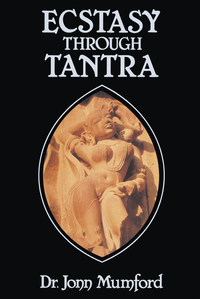
In the early 1970s, Llewellyn hosted the first modern Pagan conventions in the U.S., known as the Gnosticoons. One of the speakers at a Gnosticon was Mumford, and for the first time in the West he introduced the subject of Yoga Nidra. This easy-to-learn but little known mental discipline allows you to develop spiritually during the period between wakefulness and sleep.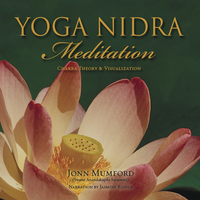 Finally, a recording of that lecture with special instructions has been made available on a CD so you can practice the method. It’s called Yoga Nidra Meditation.
Finally, a recording of that lecture with special instructions has been made available on a CD so you can practice the method. It’s called Yoga Nidra Meditation.
One of my favorite books by Mumford is A Chakra & Kundalini Workbook. 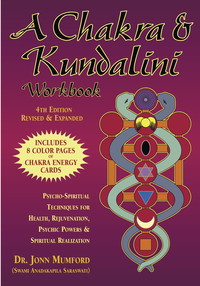 This book, which is the centerpiece of a course he taught (now taught by the holders of his tradition, Mark Michaels and Patricia Johnson), is in my opinion the best workbook available on the subject. If you’re looking for even more information, I would suggest Anodea Judith’s Wheels of Life.
This book, which is the centerpiece of a course he taught (now taught by the holders of his tradition, Mark Michaels and Patricia Johnson), is in my opinion the best workbook available on the subject. If you’re looking for even more information, I would suggest Anodea Judith’s Wheels of Life.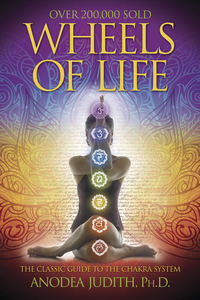
In my estimation this is a truly remarkable book discussing the chakras that is not hindered by Westernization and oversimplification. If you want to know more about the chakras, this is the book to get. And if you’re a more visual or auditory person, Anodea helped create a phenomenal video called The Illuminated Chakras.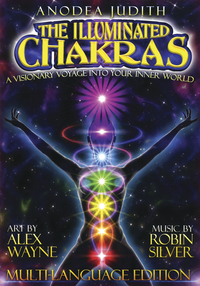 Now available as a DVD, darken your room, turn up the sound, and experience a mind-bending, trippy, journey through those vortexes of energy.
Now available as a DVD, darken your room, turn up the sound, and experience a mind-bending, trippy, journey through those vortexes of energy.
Where Is It?
There are numerous books available that, like these books, CDs and DVDs, do a great job of examining individual aspects of Tantric concepts. There are a lot more that, well, fictionalize things, blurring popular Western ideals and idiosyncrasies with Traditional Tantric beliefs and concepts. In fact, the word “Tantra” has become a catchword for just about anything. I’ve seen books that claim Tantric sex is about rolling around in the mud for an exact number of minutes (it isn’t), that Tantra is an ancient Egyptian system of sublimating sexual energy away from sex and into other things (it isn’t), and even that Tantra comes from the Pleiades (it doesn’t).
As of this writing I’ve seen no book that presents Traditional Tantra in a format that can be used by anyone and introduces people to the complete Pagan system of Tantra. I think it would make a great book. Perhaps you’ll write it. Start studying now! Maybe even I’ll give it a try.
Would you be interested in a book showing a real ancient traditional Pagan system from India?
Notes:
Yes, I am aware there are also forms of non-Indian Tantra, such as the Buddhist Tantric systems. A book that introduces a complete spiritual system, by nature, will be large. Add the Buddhist aspects to it and it would probably be too large to be published. So if you’re thinking of writing such a book, I would suggest sticking to either the Indian or Tibetan Buddhist systems.
There are a lot of links in this blog. Most of them go to free Llewellyn Encyclopedia. If you’re not familiar with it you might take a look. As I am also the editor of the encyclopedia, I am proud to say that it is one of the most complete encyclopedias focused on the occult, New Age, paranormal, etc., on the internet. The next time you see a word related to these topics and want to know more, check out the Llewellyn Encyclopedia. In fact, check it out first. If something isn’t included, let us know so we can research it.
[Update: I tend to go to bed fairly late…or early…it all depends upon how you look at it. At about 2:00 am where I live, many hours after I had written the above post but not published it, I saw that Phil Hine had written on many similar concepts in his just-published post entitled Jottings: On Defining Tantra. Although his approach is far more erudite and scholarly than my post, the similarity of our concepts is quite striking. Perhaps something is “in the air.”]One more thing…
I just wanted to mention that my new short ebook, The Magical Life of Scott Cunningham, is available now for only $1.99 u.s.!
I’m really excited about this book. I shared an apartment with Scott for six years. In this ebook I reveal what motivated him to write, his magical techniques, and many personal stories that have never previously been published.
Although not related to the topic of my post above, I’m so excited about this book that I wanted to remind you of it. By now I hope you know how much of a good friend Scott was. To find out more about this small book, see my website. Or just order it! It’s only 2 bucks from your favorite online ebook retailer, such as the Kindle Store (LINK), Kobo (LINK), Sony (LINK), and iTunes (available now through the store in iTunes). I think you’re really going to like it.
For more information on “eShorts” and the Llewellyn ebooks available in this format, see this article.








Namaste’
Greetings Mr. Kraig. I very much enjoyed this blog; there is vast need to educate the West on Tantra. As I am half Rajasthani, my father’s side, it is important to me to dispel the “sex talk”. My dear friend, Melisa Kepley, witchcraft shop owner in Newport News, Va, and I have started the “Ahimsa Tradition” two years ago, a blend of The Craft and Tantra. She is the one who forwarded this blog to me. As my heritage discovery story is long and complex, my actual deep study of Hinduism/Tantra only began 4 or so years ago. And as a practicing Witch, I am always on the look out for new literature. Write the book!! My travels to India have just begun 2 years ago to see family and study under a guru. With my next trip, I am encouraged that I will be in contact again with locals practicing Shaktism, as the Goddess Kali is my Ishta-deva. Have you read, “Kali Kaula: A Manual of Tantic Magick” by Jan Fries or “Tantra: Cult of the Divine Feminine” by Andre Van Lysebeth? Both very “meaty’ and probably not good choices for an introduction. This said, write the book! One is sorely needed and the time has come. Jai Maa!
and Blessed Be )0( Susan Earhart, Virgina
P.S.
Also, inspiring to me is that you don’t follow the common theory of Aryan Invasion, as like you stated, so many still do. I do find in India that many, regardless of what the schools may still teach, have always had issue with this theory. But India being a vast, complex “spiritual soup”, it seems not of tantamount importance. Spirit rules, even when listening to heated debates among sadhus and swamis, for most. I speak humbly as my own journey is still new in the grand scheme.
As a student of—a lover of—Tantra, perhaps you, Susan, should write a book! There is certainly room for many books that would bring the fullness of Traditional Tantra to the West. I have no doubt that your Ahimsa Tradition (to those unfamiliar with the term, “Ahimsa” is the path of harmlessness) is not what I have been doing. That makes what we each do different (not “wrong”) yet coming from the same roots.
Yes, I have read both of the books you have named. I think they’re both very good and would encourage any person studying Tantra to consider them as resources.
Namaste Don,
Thanks for the thoughtful post. One small clarification, Dr. Jonn Mumford is still teaching online and has students from around the world. The courses he teaches, which address but don’t focus on the sexual aspects of Tantra are a great way to get personal guidance from a master and a direct experience of Tantric practice, presented in a way that’s accessible, regardless of your background. We currently sponsor the courses but do not teach them. We began our studies with Swamiji online.
[…] For more information on Tantra, see my earlier post, A Book That Needs to be Written. […]